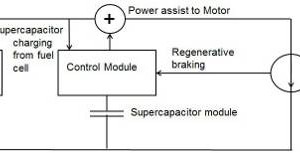Cambridge University’s supercapacitors could be used to power electric vehicles Harry Yeates
Researchers at Cambridge University are developing electrode materials for very high performance supercapacitors that could be used to power electric vehicles.
The university is also looking for investors to help commercialise the technology.
By coating multi-walled carbon nanotubes with a very thin layer of a conductive polymer called polypyrrole, Dr Mark Hughes and his colleagues have demonstrated capacitances as high as 2F/cm3.
“That’s more than double what you see for the nanotubes or the polymer alone, which is far beyond that of existing capacitors on the market,” said Hughes. The performance is a result both of the very large surface area of the nanotubes, and the electrochemical behaviour of the polymer.
The devices, which work via an electrochemical reduction-oxidation process, with charge stored on the polypyrrole molecules, are formally known as pseudo-capacitors. The available current can be tuned by using different polymers, film thicknesses and production techniques.
“It is basically something that can be adapted to a market that’s identified later on,” said Hughes. “We’ve had a few people looking at potential markets and how easily it could be transferred into them. That was one of the main benefits, it was flexible to what you could target it towards.”
There is still work to do. The anode side of the device, where the polypyrrole composite electrode material is oxidised, has been well characterised, but developing a polymer-nanotube composite that behaves well at the cathode requires more work.
“At the moment we’ve got one of them very well set up and it’s doing exactly what we want,” said Hughes. “On the other half of the capacitor, there’s still a lot of optimisation that can be done. That’s related to the chemistry of the conducting polymer – it’s easy to oxidise the polymer, but a little bit trickier to reduce it.”
Potential applications include batteries, sensors, membranes and anti-electrostatic coatings. In a battery-powered electric car the devices would be used to provide a sudden burst of power, for instance while accelerating away from traffic lights.
 Electronics Weekly Electronics Design & Components Tech News
Electronics Weekly Electronics Design & Components Tech News



